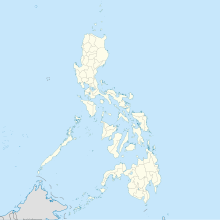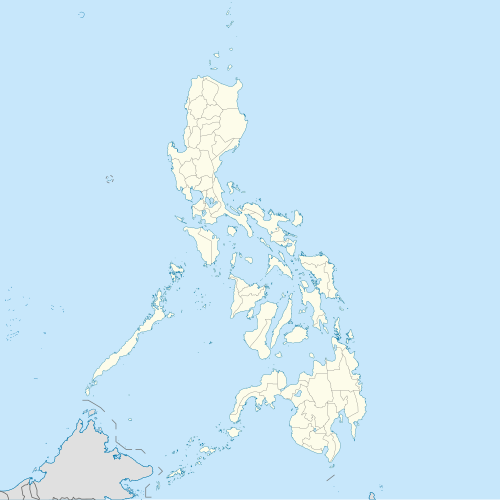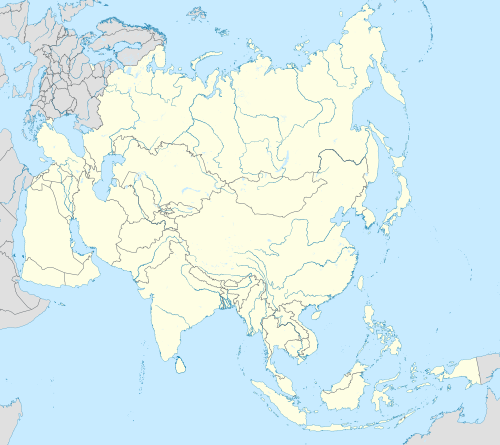Francisco Bangoy International Airport
Francisco Bangoy International Airport Tugpahanang Pangkalibutanon sa Francisco Bangoy Paliparang Pandaigdig ng Francisco Bangoy | |||||||||||
|---|---|---|---|---|---|---|---|---|---|---|---|
 The airport in January 2018 as viewed from across the runway | |||||||||||
| Summary | |||||||||||
| Airport type | Public | ||||||||||
| Owner/Operator | Davao International Airport Authority | ||||||||||
| Serves | Metro Davao | ||||||||||
| Location | Sasa, Buhangin, Davao City, Philippines | ||||||||||
| Opened | August 25, 1958 | ||||||||||
| Hub for | |||||||||||
| Operating base for | Cebu Pacific | ||||||||||
| Time zone | PHT (UTC+08:00) | ||||||||||
| Elevation AMSL | 29 m / 96 ft | ||||||||||
| Coordinates | 07°07′31″N 125°38′45″E / 7.12528°N 125.64583°E | ||||||||||
| Maps | |||||||||||
 | |||||||||||
 | |||||||||||
| Runways | |||||||||||
| |||||||||||
| Statistics (2023) | |||||||||||
| |||||||||||
Source: CAAP[1] | |||||||||||
Francisco Bangoy International Airport (IATA: DVO, ICAO: RPMD) — also commonly known as Davao International Airport — is the main airport serving Davao City and Davao Region in the Philippines. Serving as the main gateway to Mindanao, it is the busiest airport on the island and the third busiest in the Philippines in 2022.
History
[edit]Early history
[edit]The site of the airport began operations in the 1940s as Sasa Landing Field with a donation of land in barangay Sasa, located in Buhangin district of Davao City, by Don Francisco Bangoy, the then-current patriarch of an influential family that founded and settled in Davao alongside Don Jose Uyanguren. At the time it began operation, the airport merely consisted of a 1,200-meter (3,900 ft) unpaved grass runway and quonset huts serving as terminal buildings. At the time, and throughout much of the 1940s and the early 1950s, both Philippine Air Lines and the Philippine Air Force provided air service to the city.[2]
As a civil aviation airport
[edit]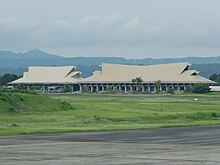
The Davao (Sasa) Airport was opened for civil aviation on August 25, 1958.[3] It initially consisted of a new 1,500-meter (4,900 ft) long by 30-meter (98 ft) wide concrete runway and a 200-meter (660 ft) long by 60-meter (200 ft) wide apron. The grass airstrip was later converted as a taxiway for general aviation.[4]
By 1959, the complex consisted of a small control tower and several low-rise buildings. On June 19, 1960, Republic Act No. 2762 was enacted which renamed the airport to Francisco Bangoy Airport in honor of the late Don Francisco Bangoy.[5] Right of way and access to the terminal buildings and the airport were improved through further donation of land by Paciano Bangoy, Francisco's son, during the latter stages of Paciano's gubernatorial term. In 1970, the runway was extended and widened to 2,000 meters (6,600 ft) and 36 meters (118 ft), respectively, while the apron was widened to 100 meters (330 ft). Five years later, the runway was further extended and widened to 2,500 meters (8,200 ft) and to the current 45 meters (148 ft), respectively.[4]
A new terminal designed by Filipino architect Leandro Locsin, with a capacity of one million passengers, started construction in 1976 and was completed in 1980. The project, in addition to runway expansions, was funded during the term of then-Congressman Manuel Garcia, whose congressional district covers the airport perimeter.[2] Airbus A300 operations by Philippine Airlines started on September 1, 1989, marking the first widebody service to the city. The first scheduled international passenger service started on April 29, 1992, with the inauguration of Bouraq Airlines flights to Manado, Indonesia.[4] After the launch of scheduled international flights to Davao, regular flights to Kota Kinabalu, Malaysia[6] and Singapore were also commenced by Malaysia Airlines in 1996 and SilkAir in 1997, respectively.[7][8]
Expansion
[edit]Rapid growth at the airport precipitated the construction of a ₱15 million interim international terminal beside the airport's then-existing terminal,[2] and then eventually a new, larger terminal building that would consolidate the two existing terminals. In planning since 1992, construction began in 2000 and was subsequently inaugurated on December 2, 2003, with a capacity double that of the old airport terminal. The construction of the new ₱2.7 billion building was funded by both the Asian Development Bank (ADB) and the European Investment Bank (EIB).[2] The modernization and upgrading of the airport facilities aim to make Davao as a hub for tourism and foreign investment in the region. Development was funded by a US$40 million loan from the ADB, co-financed by the EIB for twenty-five million ECUs, and through budgetary allocations from the government. The total cost of the project amounted to US$128 million.
As part of the modernization of the airport, the runway was once again extended to the current 3,000 meters (9,800 ft) in 2001 to accommodate future international flights.[9]
Contemporary history
[edit]On November 12, 2007, Cebu Pacific announced the airport as its third hub.[10] Likewise, Philippine Airlines announced the airport as its third hub on March 26, 2018.[11]
In June 2015, the Mindanao Development Authority announced its plans to turn the 1980–2003 airport terminal into a trade and cultural museum.[12]
Republic Act No. 11457, also known as the Charter of the Davao International Airport Authority, was approved on August 30, 2019, creating and establishing the Davao International Airport Authority, which will manage all airports in the Davao Region, including the Francisco Bangoy International Airport.[13]
Future development
[edit]The airport was slated for upgrading in 2016, but the project was shelved.[14] In 2017, an expansion project of the airport was announced.[15] Udenna Corporation submitted an unsolicited proposal in 2018 and received the original proponent status by the Department of Transportation in that year.[14]
The expansion and upgrading project would involve the expansion of the existing passenger terminal building, landside and airside developments, construction of a parallel taxiway, and the introduction of new technologies.[14]
Structure
[edit]
Terminal
[edit]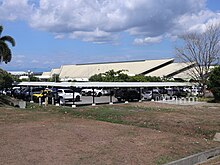
The current passenger terminal is a Malay architecture-inspired building which is four times larger than the old terminal. It is a two-level terminal building with an area of approximately 65,000 square meters (700,000 sq ft). It is fully computerized, more secure and has more commercial spaces for concessionaires at approximately 9,000 square meters (97,000 sq ft) of gross leasable area. It has four (4) jetbridges for passenger boarding. It has a Flight Information Display System and closed-circuit television system complementing the terminal's security system. It is designed to handle approximately 4 million passengers annually. The added capacity is complemented by the latest navigational, security, and baggage handling equipment.[9]
The terminal has 14 domestic and 14 international check-in counters that can handle a steady flow of passenger traffic. The check-in counters are equipped with electronic weighing scales and conveyors and its baggage handling system is also computerized. It has two arrival areas, for domestic and international flights, with two baggage conveyors each. The cargo terminal building covers almost 5,580 square meters (60,100 sq ft) and can handle up to 84,600 tonnes (83,300 long tons; 93,300 short tons) of cargo annually.[9]
Runway
[edit]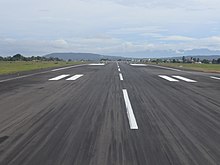
The airport has a single 3,000-meter (9,800 ft) long by 45-meter (148 ft) wide runway that can handle basically all passenger wide-bodied aircraft, including the Airbus A380. Complementing the runway are two (2) turning pads at each end of it, which help aircraft make a backtrack. The installation of a new instrument landing system (ILS) for both Runways 05 and 23 upgraded its compliance to International Civil Aviation Organization (ICAO) operating category-Precision Approach Category 1. It can accommodate 8 to 10 aircraft landings per hour, depending on size and has the equivalent 9 gate holding areas for those aircraft. The airport has two dual access taxiways. Taxiways A3 and A4 are used to access the new ramp and terminal; taxiways B and C are used for access to the old airport ramp.[16]
The Antonov An-124 is, by far, the largest aircraft to land at the airport. It is the fourth largest aircraft in the world, next to the Boeing 747-8.
Other structures
[edit]Besides the main terminal building, there are also new support facilities like the administration building, airfield maintenance building, central plant building, hangar for military and training aircraft, and an ARFF building. It has an 800-slot car parking area and four slots for shuttle buses. It has a 3-megawatt (4,000 hp) standby power generator.
Airlines and destinations
[edit]Passenger
[edit]| Airlines | Destinations |
|---|---|
| Cebgo | Cagayan de Oro, Siargao |
| Cebu Pacific | Bacolod, Bangkok–Don Mueang,[17] Caticlan,[17] Cebu, Clark, Hong Kong,[18] Iloilo, Manila, Puerto Princesa,[17] Tacloban,[17] Tagbilaran, Zamboanga |
| PAL Express | Cebu, Manila, Tagbilaran |
| Philippine Airlines | Manila |
| Philippines AirAsia | Manila (ends January 22, 2025)[19] |
| Qatar Airways | Doha |
| Scoot | Singapore |
Cargo
[edit]| Airlines | Destinations |
|---|---|
| JD Airlines | Shenzhen[20] |
| Skyway Airlines[21] | Cebu, Clark |
| Destination maps |
|---|
Statistics
[edit]Data from the Civil Aviation Authority of the Philippines (CAAP).[22][23][24]
Graphs are unavailable due to technical issues. Updates on reimplementing the Graph extension, which will be known as the Chart extension, can be found on Phabricator and on MediaWiki.org. |
An em dash (—) is used when data from CAAP is not available.
| ||||||||||||||||||||||||||||||||||||||||||||||||||||||||||||||||||||||||||||||||||||||||||||||||||||||||||||||||||||||||||||||||||||||||||||||||||||||||||||||||||||||||||||||||||||||||||||||||||||||||||||||||||||||||||||||||||||||||||||||||||||||||||||||||||||||||||||||||||||||||||||||||||||||||||||||||||||||||||||||||||||
Access and transportation
[edit]
The airport is connected to the city via the Carlos P. Garcia National Highway. The four-laned La Verna-Mamay Bypass Road was constructed and finished in 2017 near the airport to decongest traffic going from Mamay road to the airport and beyond and vice versa, by avoiding the usually busy intersection of Mamay Road and the Carlos P. Garcia National Highway. To avoid widening a road, which would displace houses and creep onto the airport's site, the road splits into two for 600 meters then merges back. It has a length of 1.7 kilometers, and is able to accommodate 1,000 vehicles per day.[25]
The planned Davao City Expressway will further connect the airport to the city via a diamond interchange. If it goes according to plan, the entire project will be completed in 2026.[26]
Accidents and incidents
[edit]- On April 19, 2000, Air Philippines Flight 541, a Boeing 737-200 en route from Manila to Davao crashed near the airport, killing 131 people.[27][28]
- On March 4, 2003, a bomb exploded in the waiting shed outside the old terminal building, killing 21 people. At least 145 others were injured.[29]
- On the night of August 25, 2008, a Philippine Air Force Lockheed L-100 Hercules bound for Iloilo City crashed into Davao Gulf shortly after takeoff. The aircraft sank 800 feet into the gulf. The incident killed nine crew members plus two Philippine Army soldiers.[30][31] After several days of a search-and-retrieval operation, the wreckage was found with the help of a US Navy ship, the USNS John McDonnell.[32]
- On June 2, 2013, Cebu Pacific Flight 971, an Airbus A320 carrying 165 passengers inbound from Manila, overshot the runway during a heavy rain. There were no fatalities, but the plane was heavily damaged.[33]
See also
[edit]References
[edit]- ^ "Aircraft, Passenger, and Cargo Movements" (PDF). Civil Aviation Authority of the Philippines. Archived from the original (PDF) on December 27, 2021. Retrieved February 3, 2022.
- ^ a b c d Ajero, Antonio M. (December 1, 2003). "Nonoy Garcia, Elias Lopez and other airport tales". SunStar. Sun.Star Davao. Archived from the original on December 21, 2003. Retrieved December 14, 2008.
- ^ "Speech of President Garcia during the inaugural ceremonies of the opening of Davao Airport, held at 9:30 a.m., August 25, 1958". Official Gazette.
- ^ a b c "2.4.1 National Development Plan" (PDF). Japan International Cooperation Agency. March 1993.
- ^ "Republic Act No. 2762". Senate Legislative Digital Resources. Retrieved November 6, 2022.
- ^ "Malaysia Airlines March 30, 1997 Route Map". DepartedFlights. Retrieved January 17, 2025.
- ^ "MALAYSIA AIRLINES TIMETABLE 1996". Pinterest. Retrieved November 18, 2022.
- ^ "SilkAir marks 20th year in Davao". Sunstar Davao. February 21, 2017. Retrieved November 18, 2022.
- ^ a b c "Upgraded Davao City International Airport Is Ready for More Passengers and Bigger Aircraft". Archived from the original on July 5, 2009.
- ^ "Cebu Pacific to make Davao its 3rd hub" (Press release). Cebu Pacific. November 12, 2007. Archived from the original on November 17, 2007. Retrieved November 12, 2007.
- ^ Cayon, Manuel (March 26, 2018). "Hong Kong, Bangkok eyed for next foreign route of PAL's Davao hub - Manuel Cayon". BusinessMirror.
- ^ Francisco, Carmelito Q. (June 16, 2015). "Old Davao airport set for conversion to trade hall". BusinessWorld. Retrieved November 17, 2022.
- ^ "Duterte approves creation of Davao International Airport Authority". Philippine Daily Inquirer. September 10, 2019. Retrieved September 14, 2019.
- ^ a b c Mellejor, Lilian (April 4, 2019). "Udenna eyes Davao airport project". Philippine News Agency. Retrieved November 17, 2022.
- ^ "With more people going to Davao, expansion of international airport gets a boost". Interaksyon. August 3, 2017. Retrieved November 16, 2022.
- ^ "Airports – Davao Int'l Airport". CAAP. Archived from the original on August 29, 2012. Retrieved September 1, 2012.
- ^ a b c d Liu, Jim (August 6, 2024). "Cebu Pacific Expands Davao Network From late-Oct 2024". AeroRoutes.
- ^ Liu, Jim (August 16, 2024). "Cebu Pacific NW24 International Network Additions – 15AUG24". AeroRoutes.
- ^ "Philippines AirAsia NW24 Service Changes – 10NOV24". Aeroroutes. Retrieved November 11, 2024.
- ^ "JDL2721 on FlightAware". FlightAware. Retrieved November 5, 2024.
- ^ Salcedo, Dirk Andrei (June 5, 2024). "New PH cargo airline receives Boeing 737 freighter". Aviation Updates Philippines.
- ^ Civil Aviation Authority of the Philippines (July 23, 2018). "Yearly Passenger, Cargo and Aircraft Movements of all airports in the Philippines 1997-2017". Republic of the Philippines - Freedom of Information Portal. Retrieved August 13, 2018.
- ^ "Statistics | Civil Aviation Authority of the Philippines". Archived from the original on May 11, 2020.
- ^ Civil Aviation Authority of the Philippines. "Aircraft, Passenger, and Cargo Movements". Retrieved September 23, 2024.
- ^ Alama, Rudolph Ian (June 29, 2018). "New bypass road opens in Davao City". Philippine Information Agency. Retrieved November 30, 2019.
- ^ "Project description" (PDF). eia.emb.gov.ph. 2019. Retrieved March 23, 2020.
- ^ "Air disaster timeline". BBC News. November 30, 2007. Retrieved July 16, 2012.
- ^ "Accident description". Aviation Safety Network. May 19, 2000. Retrieved July 16, 2012.
- ^ "Philippines airport bomb kills 18 – March 4, 2013".
- ^ "Hercules goes down in Davao Gulf; 9 missing". Philippine Daily Inquirer. August 27, 2008. Archived from the original on October 24, 2008. Retrieved July 16, 2012.
- ^ Ranter, Harro. "ASN Aircraft accident Lockheed L-100-20 Hercules 4593 Barangay Bukana, San Pedro Extension, Davao City". aviation-safety.net. Retrieved May 29, 2017.
- ^ "US Navy ship to help locate crashed C-130". Philippine Daily Inquirer. Cebu Daily News. August 30, 2008. Archived from the original on November 22, 2008. Retrieved July 16, 2012.
- ^ Manlupig, Karlos (June 2, 2013). "Cebu Pacific plane overshoots Davao airport runway". Rappler. Retrieved June 3, 2013.
External links
[edit]- AECOM
- What's On & Expat Magazine, June 18, 2006 – Upgraded Davao City International Airport Is Ready for More Passengers and Bigger Aircraft
- Current weather for RPMD at NOAA/NWS
- Airport information for DVO / RPMD at Great Circle Mapper. Source: DAFIF (effective October 2006).
- Accident history for DVO / RPMD at Aviation Safety Network


